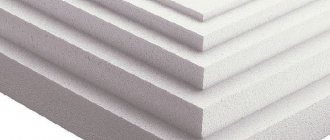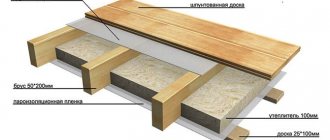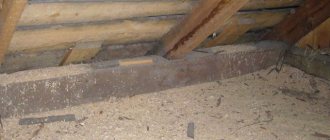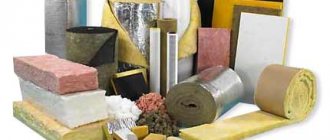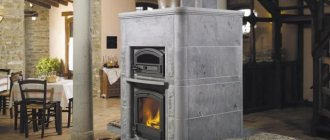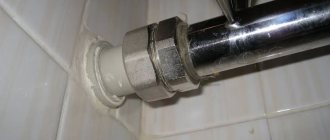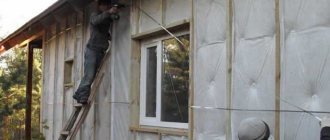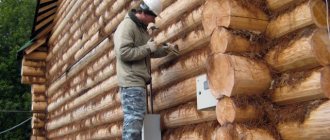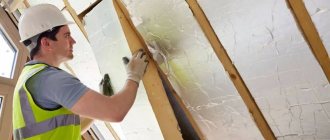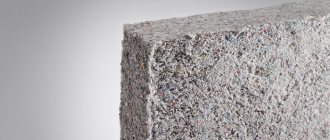Builders with significant experience in the field of roof insulation argue that in order to insulate cold-type roofing structures, it is necessary to use backfill insulation. This insulation is used when arranging the attic floor and is poured into the space between the joists. About 20% of heat loss occurs due to poorly insulated roofing, and that is why such a measure is not superfluous. The vast majority of builders agree that thermal insulation must be installed in any heated room. But if we consider the issue of choosing a material for thermal insulation, then such solidarity is not observed between builders: some of them use materials created using modern technologies, while others prefer to insulate the roof with sawdust. In this article you will learn how to use wood waste to optimize the temperature regime in your home.
How to use sawdust for insulation
Sawdust began to be used long ago in the construction of houses, then they were combined with clay and finished off the floors in rural houses. The mentioned ceilings were of good quality, served for a long time, nothing disturbed their cover, they had many advantages: low cost and good thermal insulation.
Taking this into account, the current industry began to produce effective materials for construction with similar properties - concrete with shavings, wood blocks, wood concrete.
Sawdust is also used in low-rise buildings today. Often these raw materials are of interest to individuals who want to insulate walls, ceilings and floors with shavings, and also use them as needed for other purposes.
It is difficult to find in our time a more inexpensive heat-saving material, which is sawdust. By mixing cement, gypsum or lime with shavings, you get very economical insulation for various structures.
Types of sawdust products
You can insulate the floor not just with sawdust, but with insulating materials created using them.
Sawdust granules
They are obtained by mixing sawdust with glue. Antiseptic additives must be included in the mixture. The granules retain the thermal insulation properties of ordinary sawdust, but have better resistance to rotting and are difficult to ignite.
Sawdust granules
Sawdust concrete
These are ready-made blocks of insulation obtained by mixing sawdust with sand and cement in different proportions. It is used for construction purposes, but for floor insulation it is better to take blocks with a high sawdust content. They are less durable, but their thermal conductivity is lower.
Sawdust concrete blocks
Arbolit
To make arbolite blocks, large wood chips are used, mixed with cement mortar without adding sand.
Arbolit
We process sawdust before insulation
Sawdust is used to make thermal insulation; it is prepared in advance in a special way. When an antiseptic is not used and there are inclusions of impurities in sawdust, two shortcomings arise: the flammability properties increase and rodents begin to inhabit them.
Therefore, before starting work, the shavings are mixed with cement or gypsum, lime, and then moistened with an antiseptic substance. The resulting mixture acquires suitable fire safety characteristics and is unacceptable to various pests.
Do-it-yourself insulation with sawdust (step by step)
Often, shavings are used to create insulation in a one-story building.
To make chip insulation on your own, you will need to get:
- Cement mixture, shavings, lime;
- Watering can, shovel;
- Wood antiseptic – boric acid, copper sulfate;
- Container for mixing.
The thickness of the heat-saving layer is determined by 2 rules: the local climate and the purpose of the room.
You should know. When the building will be used only in summer conditions, then an insulation layer of 25 cm for the ceiling with overlap and 15 cm for the walls is sufficient.
When you plan to live in the house for a year, then you need to add the thickness of the ball to 30 cm. To do this, you will need to add racks, they form additional space for backfill.
Installation technology
The effectiveness of roof insulation with a thermal insulation mixture based on sawdust and clay or lime depends on the correct installation, as well as on the quality of the preparatory work. It is necessary to treat wood shavings with preparations, fire-retarding compounds, an antiseptic, and add substances that repel rodents and insects. Insulation of a cold roof with sawdust is performed in the following sequence:
- The wiring running through the attic floors is insulated and stored in metal pipes. Chimney pipes, air ducts and other communications are finished with fire-resistant material or covered with crushed stone.
- Using wooden boards, formwork is installed on the subfloor. For this operation, you can use substandard wood or slab.
- To protect the sawdust from moisture, a waterproofing material (high-diffuse membrane or glassine) is spread on the surface of the subfloor, secured with a construction stapler to metal staples.
- The thermal insulation mixture of sawdust and clay or lime is mixed in small portions, and then, without delay, evenly poured onto the waterproofing material in a layer of 25-30 cm. If a dry mixture is used, it is additionally compacted.
- The thermal insulation layer is carefully leveled and then left to dry for 2-3 weeks.
- After drying, the insulating mixture of sawdust and clay is again covered with waterproofing material, which is secured with a stapler to the floor joists.
- The last stage of insulating the attic floor is laying the finished floor.
Selection of sawdust
There are several types of sawdust that differ in size. There is material: small, medium and large fractions. It is best to choose the middle fraction, since small sawdust is difficult to work with, and large sawdust cannot provide high-quality insulation.
- It is advisable to choose sawdust that was obtained by sawing dry wood in carpentry; they do not require additional preparation and do not rot.
- After acquiring sawdust that was formed after sawing round timber with natural moisture, you need to dry it. When it comes to selecting the type of tree, it is better to choose shavings from coniferous trees.
The resin contained in them prevents the appearance of any insects in the sawdust. Larch is a great choice for insulating a bathhouse.
It is necessary to ensure that there are no foreign impurities or any debris in the sawdust. If it is found, then you need to sift the sawdust using a sieve. Large debris items are manually selected.
Characteristics of insulation
Sawdust is, due to its natural origin, a healthy insulation material that is a product of the woodworking industry and is purchased at sawmills. This material was used to insulate a private house back in Rus', and continues to be used now. Sawdust has a number of advantages that distinguish it from other insulation materials:
- Price. Often such material is given away for free, since it is waste from sawmills and sawmills. The cost in such cases only includes delivery to the construction site.
- Harmlessness. They do not cause poisoning or allergic reactions, as they do not produce toxic fumes.
- Thermal conductivity. Sawdust provides excellent thermal insulation due to the fact that it has a huge number of air cavities. Compared to ordinary wooden beams, they have lower thermal conductivity.
- Organic. The shavings retain all the properties of wood, thanks to this they allow moisture and air to pass through well.
- Installation. To insulate a roof with sawdust, you do not need specialized knowledge or tools. Anyone can prepare the mixture and lay it on the ceiling.
Surface preparation
Before you start insulating the floor with sawdust, you need to prepare:
- The plane of the beams is covered with boards. The thickness of the timber should be at least 30 mm. It is limited by the distance where the beams are located between each other.
- The planks are laid very close to the beams, driven in with nails or screwed in with self-tapping screws.
- Before work, boards with beams are treated with an antiseptic to stop the possible formation of fungi and to protect the structure from insects.
- The holes are filled with construction foam.
- In the attic, the ceiling is covered with a layer of vapor insulation. In its absence, it is possible to use roofing material. Vapor insulation is secured with a stapler with allowance for walls and beams.
Wall pie device
One of the most important factors when building a house is the correct design of the walls. It doesn’t matter whether you carry out all the construction work yourself, or order a ready-made option, in any case, you must know the correct composition of the “pie” of a frame house.
Layers of the correct “pie” of the wall:
- Frame made of wooden beams.
- There should be insulation between the racks.
- Fiberboard (OSB).
- Horizontal sheathing.
- Insulation.
- Multifunctional membrane.
- Vertical lathing.
- Finishing.
- Vapor barrier.
- Internal lining.
wall pie
Alternative option
If you use sawdust as wall insulation, you need to make a lathing.
First of all, you need to mount the frame. Then, at a certain distance, you need to attach wooden slats to the wall and lay the sheathing on them.
Sawdust mixed with cement
To insulate the ceiling with sawdust, you will need to dilute it with cement. The resulting solution will be capable of becoming similar to concrete when hardened. This method is best used on concrete floor surfaces.
The insulation solution is prepared in the following order:
- In a large container, lime is mixed with the addition of cement in proportions of 1:1. Then sawdust is thrown into the solution - 10 parts and mixed thoroughly. Water is added to form the desired fluidity. To determine the correct thickness, take a small amount of the mixture in your hand and squeeze it in your palm. After unclamping, the lump should not disintegrate and water should not flow out;
- The openings in the ceiling are filled with a mixture 20-25 cm thick.
The advantage of the described method is that concrete with sawdust will take less time to harden than clay with sawdust. This makes it possible to use this method when it gets cool in autumn or spring.
Preparatory work
How to insulate a ceiling with sawdust in a private house?
Whatever method is chosen, preliminary preparation of the wooden base is required. Initially, the elements on the ceiling are processed. As a rule, during construction they use material that has already undergone appropriate processing. However, in some cases this procedure is skipped. Then you need to do it yourself. For processing, it is recommended to choose drugs from the same brand. Some manufacturers offer products that perform several functions at once, for example, protect against fire and high temperatures, prevent rotting and insect damage. The bathhouse must be treated with special products that are resistant to high humidity and high temperature.
We suggest you read: How long does fireclay clay take to dry?
After processing and drying of wooden structures and ceilings, the substrate is laid.
Initially, all gaps and cracks should be sealed. To do this, use polyurethane foam and acrylic sealant. Large cracks are treated with foam. Gaps and joints are sealed with sealant. It is allowed to use bitumen mastic, but not for finishing the ceiling of a bathhouse. This is due to the low resistance of the material to high temperatures.
You need to seal not only the holes in the wooden ceiling, but also in the roof itself. This increases the thermal insulation properties and eliminates the impact of external factors on the internal elements of the roof.
An excellent and inexpensive option is to lay cardboard. It can be any type of material. The main condition is that the cardboard must be dry. The sheets are laid directly on the ceiling, with an overlap of 15-20 cm on each other. If the cardboard is thin, then it should be placed in 2-3 layers. The joints are fastened with staples. The perimeter of the junction of cardboard and walls is treated with polyurethane foam or sealant.
PVC film is often used as a backing. It is also laid with an overlap of 10-15 cm, and additionally secured with staples using a stapler. The edges of the film around the perimeter should extend onto the walls/roof by 10-15 cm.
Insulation with a mixture of shavings and clay
Before mixing, sawdust should be carefully prepared. To make a solution, you need to follow the necessary procedures:
- Water is poured into 5 buckets of clay. The clay is given time to soak, after which it must be mixed with water to form a homogeneous mass. Sawdust is poured into the container and clay is added in small quantities. The resulting substance should be of medium thickness;
- The ceiling plane is covered with glassine or film, which is secured with a stapler. A mortar with a thickness of at least 5 cm is applied for summer buildings and 10-12 cm for winter buildings. The mixture is easily compacted. It dries for a few days, and after 3 days the cracks become clogged. This is done with mortar or clay only. The insulating layer is allowed to dry.
What will be the price for sawdust insulation? There is a price of 100-400 rubles - a conditional price, the master calculates the final cost on the spot.
Reviews
Let's consider reviews about sawdust insulation. One man shared that one of his friends built a house in one large city. That man knew about construction issues; he used masonry resembling wells and filled them with a clay mixture with sawdust.
As a result, it turned out that he got almost nothing insulating material. The house came out very warm in winter and cool in summer.
Alexander, an experienced builder, shared that no one would argue about ceiling insulation - this is a popular and useful thing. In winter, such a ceiling retains heat, and in summer it is cool in such a house. This results in energy savings. In general, many reviews talk about the benefits of this insulation for house ceilings.
Choosing the right material for ceiling insulation
Polyurethane foam from Ecotermix has many useful properties, which are discussed in the video below:
Polyurethane foam has earned significant fame and popularity due to its properties as a heat insulator.
Let's make a list of the main criteria that an ideal heat insulator must meet:
- high heat retention rate;
- non-flammability;
- resistance to moisture, rotting, insects;
- light weight;
- simplicity and high speed of installation;
- durability and reliability;
- tightness;
- environmental Safety;
- reasonable cost.
Among the vast majority of modern options, only one immediately meets all the criteria: sprayed polyurethane foam from Ecotermix. Being a relatively new method of insulation, such technology has been widely used in the USA and Europe for several years. However, in the short period of time that has passed since its appearance in Russia and the CIS countries, this material has managed to earn significant fame and popularity due to its properties as a heat insulator. In addition to the qualities listed above, additional advantages of its use can be noted:
- high level of adhesion (the material easily and reliably sticks to any surface);
- complete tightness of the thermal insulation layer (even direct contact with moisture will not cause dampness and rotting of the ceiling);
- due to moisture resistance and tightness, there is no urgent need to apply vapor and waterproofing;
- the speed of application of the material allows you to process more than 100 square meters of surface in 1 working day;
- Due to its structure, polyurethane foam completely fills the gaps on the surface, providing the maximum level of heat retention.
Ecotermix polyurethane foam can be used to insulate any surfaces of any buildings (it is widely used as a heat insulator for frame and wooden houses, bathhouses, garages, non-residential premises, balconies, sewer systems). Its use allows you to achieve the highest possible efficiency - something that other materials cannot provide.
We recommend watching a video about ceiling insulation with PPU from Ecotermix to have an idea of how this happens and why PPU is considered the best among other insulation materials

